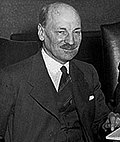This article needs additional citations for verification .(April 2025) |
| Minister of Defence | |
|---|---|
 | |
| Ministry of Defence (1947–1964) | |
| Status | Abolished |
| Member of | Cabinet |
| Reports to | Prime Minister |
| Appointer | The Monarch (on the advice of the Prime Minister) |
| Term length | At His Majesty's pleasure |
| Precursor | Minister for Co-ordination of Defence |
| Formation | 10 May 1940 |
| First holder | Winston Churchill |
| Final holder | Peter Thorneycroft |
| Abolished | 1 April 1964 |
| Superseded by | Secretary of State for Defence |
The post of Minister of Defence was responsible for co-ordination of defence and security from its creation in 1940 until its abolition in 1964. The post was a Cabinet-level post and generally ranked above the three service ministers, some of whom, however, continued to also serve in Cabinet.













